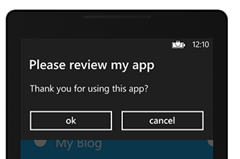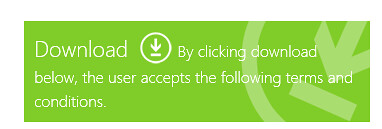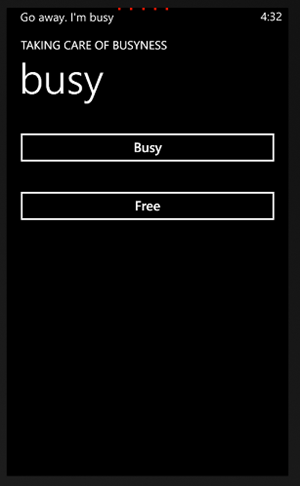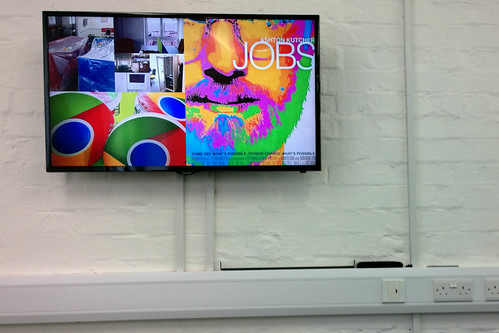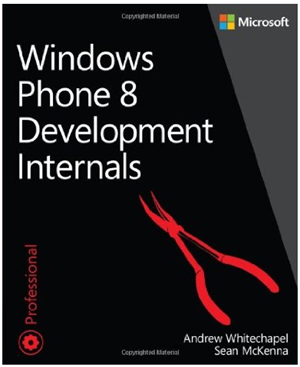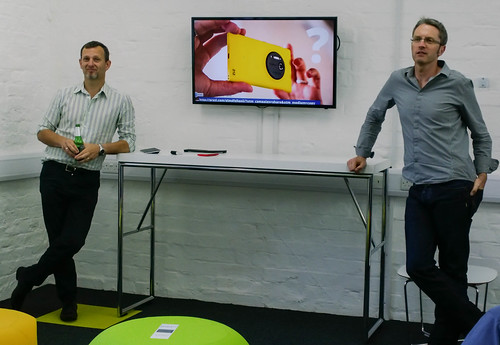
Simon Hudson (left) and Jon Moss, with a Lumia 1020 in the middle..
I seem to be spending a fair bit of time at C4DI at the moment. Tonight I was there for the first of their “You really should be..” events. The format is simple enough. Take the words “Your really should be..” and put them in front of something that you can talk about for fifteen minutes. Then take questions and repeat twice. It works really well, generating discussion and interesting things to do in equal measure. And the first topic was right up my street, when Simon Hudson spoke on “You Really Should Be giving a Windows phone a try”. Absolutely.
Simon gave a great description of what makes Windows Phone is such a nice platform, starting with some impressive sales figures (now phone platform number three) and moving on to the neat and useful things you can do with the device. Of course, I don’t need convincing of any of this, but it was lovely to hear someone else voice the same opinions and give some strong context about how Windows Phone is proving so useful to them. Highlights were Voice SMS, Live Tiles and Rooms. You can find Simon’s presentation here. For me the killer fact was that his daughter was into Windows Phone first and he got his after her.
Next up was David Gilson: “You Really Should Be buying Bitcoins!”. Bitcoins are “maths made money” in that the actual currency is created as a series of mathematical proofs, each of which identifies a particular coin. Coins are mined by computers that grind through calculations to generate the proofs which are assigned to owners.
When you buy a bitcoin or use part of it to pay for something the transaction is stored as part of the bitcoin infrastructure in a series of tamperproof blocks. You can use bitcoins to pay for stuff and you can buy them and keep them in your digital wallet. There are 21Million possible Bitcoins out there, and they will get both harder to mine and more valuable over time. At the moment around half the Bitcoins have been “mined” and people are investing in ever more powerful systems to find more. The idea is to do away with the present volatile paper based currency systems and replace them with something clean and mathematically sound.
As you might expect, the world of finance is looking a little askance at this attempt to make an end run around the systems that have made, and are keeping them rich. Bitcoins, with their untraceable ownership and easy electronic transfer, are also also ripe for use by various unsavoury enterprises. Me, I’ll be keeping my cash in traditional forms for the time being, but David did make a very compelling case for “having a flutter” on Bitcoins.
Finally Jon Moss rounded off a very enjoyable evening with a session called “You Really Should Be using Textexpander”. The TextExpander program installs on your Mac and allows you to create and manage keyboard shortcuts to vastly improve your speed when creating documents. Rather than typing “From the pen of the desk of Rob Miles” at the end of each email I could assign that to ESIG or some other combination of letters and numbers. TextExpander monitors your keyboard and then inserts the expanded version when it sees the shortcut.
That’s nice enough, but there is a lot more besides. You can create template documents, for example meeting minutes or email responses and have them all created automagically. If you find yourself typing the same phrase, or building the same document, time after time then this system would save you a lot of work.
It is a pity that the program is only available on Mac (although it is available across all the Apple platforms and works really well on iPhone and iPad). If you fancy having a go at this and are using a Windows PC Jon reckoned that PhraseExpress is your best bet.
It was an absolutely great evening. And when I went out of the office I was able to grab a nice picture of The Deep again.

C4DI have set up a web site:
http://www.youreallyshouldbe.com/
You really should be keeping an eye on it.
Update on 2013-08-28 12:27 by Rob
You can find David's Bitcoin slides here and a video of his talk here.




